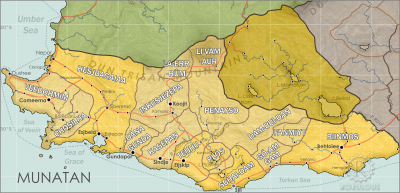Go-Ám-Gam
Go-ám-gam [go-AM-gam] is a sparsely-inhabited nation in southeastern Munatan, consisting mostly of temperate upland hills and rugged coast with temperate viridplugin-autotooltip__small plugin-autotooltip_bigVirid
Referring to the Virid Kingdom of flora and fauna, toxic to human life. forests and no navigable rivers. Its only principle city is Go-ím-ri, situated some miles inland from the sea.
Munatanplugin-autotooltip__small plugin-autotooltip_bigMunatan (Category)
Articles about Munatan, the far southern region of Anásthias.
Nations
Cities
topics regi1
 Hover mouse to see more detail | Go to full atlas mapplugin-autotooltip__small plugin-autotooltip_bigAtlas: Munatan
Hover mouse to see more detail | Go to full atlas mapplugin-autotooltip__small plugin-autotooltip_bigAtlas: Munatan
[munatan.png] * Zoom out * East Munatan * West Munatan
This is in a series of articles about Munatanplugin-autotooltip__small plugin-autotooltip_bigMunatan
Munatan [Moo-Nah-Tahn] is the southernmost region of Anásthias, south of the Dun Trisan mountains. The name possibly derives from a ancient Thalsic, meaning “Land of One Sun”, since the daystar is not visible in the southern hemisphere. Or it may be a reference to the Manthi people who were once the majority population of western Munatan. The term is an OrorrOrorrOrorrHartheraHartheraOrorrOrorrOrorrHartheraHartheraHartheran, the temperate region of southern Anásthiasplugin-autotooltip__small plugin-autotooltip_bigAnásthias
Anásthias [a-NAS-thee-ass / ænæsθiːæs], or [an-ass-THEE-as] is an equatorial island continent, heart of the Civilised World. The north straddles the equator and is hot and humid, while most of the equatorial centre is an upland plateau with fertile river valleys, and stretches of arid plains and desert in the shadow of the mountains. The south is temperate but more wild, separated from the civilisations of the north by the almost impassable Harthera.
Culture
Go-am people follow a belief in the Twelve Paths, different way to wisdom using different beliefs, rituals and epitomising certain character traits. The paths were originally associated with different tribes within the nation, but now paths are generally adopted by different families, and it is common for different paths to live together with only occasional conflict.
Governance
The nation is nominally ruled by a monarch called the Ka-mém-gong, who is chosen as a child for being intelligent and able to pass a number of intellectual and moral tests. Such children are said to inherit at birth an ancestor spirit from one of the Twelve Paths. The tests are designed to detect the presence of which spirit.
There are usually three generations of Ka-mém at any one time - the Ka-mém-gong, the current ruler, the ha-mém-ang, the heir, and the si-mém-gum, the “baby”.
The Ka-mém-gong is required to live a pure moral life and abstain from wine and sexual intercourse, and is forbidden from marrying. Human vices, intoxication, and physical pain or illness, are said to drive the spirit from the body. They generally rule for twenty years or so, until they wish to retire or marry, or the council declares that the spirit has left them. Retiring leaders are rewarded with gifts of land or riches, and generally return to their family village and marry.
The ha-mem-ang then becomes ka-mem-gong, and the search then begins for a new si-mem-gum. Candidates must have been born in the time since the spirit left the ka-mem-gong, and the search can take a year or more. Traditionally each of the Path Temples takes it in turns to select a new si-mém-gum, though sometimes “omens” or other portents (in practice, political interventions) give certain temples dominance.
The ka-mém children are trained and educated in a temple, with their parents having a place of honour.
Though the Ka-mém-gong is technically the supreme ruler with power of life and death, in practice they are guided by a Council of Elders, who work with clan elders and the heads of various towns and villages.
